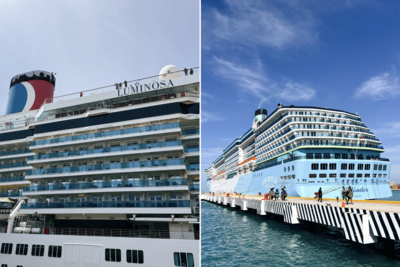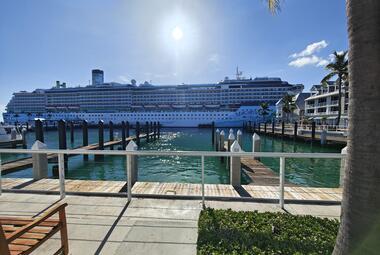Costa Cruises is most known for the deadly capsizing of the Costa Concordia in 2012, where over 30 people lost their lives when the ship's captain strayed from the original course and sailed dangerously close to the Tuscan island of Giglio.
Still, many travelers report disappointing experiences aboard Costa ships, and it's often thought of as the worst-rated cruise line at sea. Common complaints include poor-quality food, bad customer service, dirty cabins, and disorganized operations.
Although I haven't technically sailed with Costa Cruises, I have embarked on two voyages aboard former Costa ships: Carnival Luminosa (formerly Costa Luminosa) and Margaritaville at Sea Islander (formerly Costa Atlantica).
Read more: What happened to the Costa Concordia?
Despite being operated by different lines, their shared DNA was impossible to miss
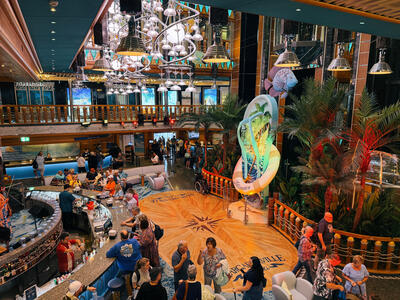
Margaritaville at Sea's Islander initially debuted in 2000 as Costa Atlantica and was the first-ever Spirit Class ship to enter service. Today, Spirit Class ships — including Carnival Miracle, Carnival Pride, Carnival Legend, and Carnival Spirit — primarily operate for Carnival Cruise Line.
Still, the original Spirit Class ship served as a blueprint for later vessels, specifically Costa Luminosa, which launched in 2009. However, Costa Luminosa's design also borrowed elements from Holland America Line's Vista Class.
Walking onto both ships, I was greeted by a multi-story atrium. The buzzing hub featured a lively bar, glass elevators, the Guest Services desk, and easy access to the casino, theater, and main dining room.
Read more: I survived 7 days on the world’s worst-rated cruise line
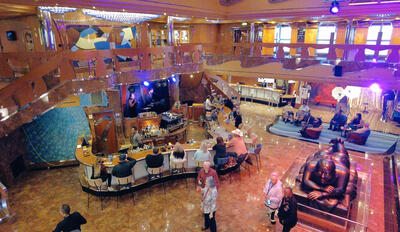
Whereas Islander's atrium sported a larger-than-life flip-flop, Luminosa's kept the iconic "Reclining Woman 2004" sculpture commissioned by renowned Colombian artist Fernando Botero for the original vessel.
On a similar note, Luminosa's atrium retained more classic Italian charm than Islander's, which was designed to lean into the beachy vibe of the Margaritaville brand.
However, this made Luminosa's atrium feel more dated, a trend that was consistent throughout much of the ship compared to Islander's contemporary, tropical aesthetic.

The top decks had a similar layout, too. For example, the specialty steakhouses were on Deck 10, directly above the ship's complimentary buffet.
Their open floor plans meant that, regardless of whether you were grabbing a slice of pizza or enjoying a multi-course specialty meal, you could hear the excitement in the atrium.
Moreover, the adult-only spaces were on Deck 9 aft, directly outside the buffets. I appreciated how Islander made the space feel like a sought-after getaway, while Carnival didn't seem to invest much in the adult-only area.

For instance, on Islander, there are two specialty restaurants comfortably tucked away from the buffet crowds. Comparatively, although there was space for a BBQ station on Luminosa's Serenity Deck, the outdoor venue remained unused.
While we were sailing in chillier temperatures than Islander, utilizing the extra space would have helped mitigate the crowds in the buffet, even for an hour during the lunch rush. I wouldn't have minded grabbing food outside since the dishes inside the buffet were often cold anyway.
Updating Luminosa's cabins was an afterthought for Carnival
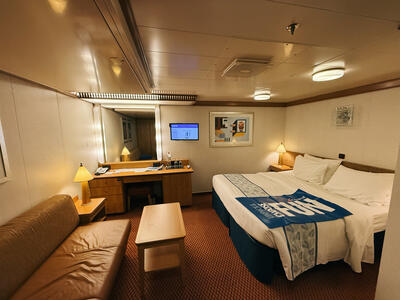
I was surprised by how spacious my inside cabin was on Carnival Luminosa. However, it wasn't as updated as my stateroom on Islander; the yellow and orange wood tones, dark patterned carpeting, and tiny television highlighted the ship's true age.
In comparison, my cabin on Islander was bright and tropical — almost like a boutique hotel room in Key West, Florida.
Although one stateroom was a standard interior and the other a suite with a spacious balcony, I noticed stark differences in the attention given to the cabins.
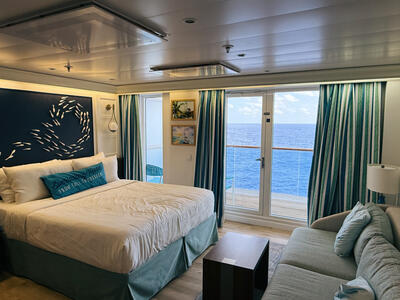
Carnival Luminosa’s interior, while roomy, felt more like a throwback, while the fresh furnishings on Islander gave a welcoming and relaxed vibe. It certainly didn't feel like a cabin from 2000, that's for sure!
Carnival's fast-casual food didn't meet expectations

Carnival is known for fast-casual venues like BlueIguana Cantina, Guy's Burger Joint, and Big Chicken. However, I thought the food on Margaritaville's Islander was more of what you'd expect on a Carnival ship than Luminosa!
For instance, everything from Mexican Cutie Cantina tasted fresh, while the tacos and burrito bowl from Tacos & Burrito were a major letdown.
The chicken aboard Carnival Luminosa constantly tasted dry and overcooked, and the toppings, such as pico de gallo and rice, tasted like they'd been sitting out for too long.

Off the Grill served a more memorable burger than the lackluster tacos, but it wasn't the same as Guy's Burger Joint, and I missed the extensive toppings bar — not to mention the uncovered bowls of condiments that felt gross and unsanitary on Luminosa.
On the other hand, I was impressed with the Cheeseburger in Paradise Burger Bar aboard the Islander. The seasoned fries packed more of a punch than those served on Islander, and the beef patty was cooked just right. The outside was perfectly charred without sacrificing the juiciness of the beef patty.
The buffet on Carnival Luminosa was another letdown. Nearly everything I tried was served cold. A few things were inedible, too, including the limp kung pao chicken from the Asian station on embarkation day.

I found it ironic that the food on Margaritaville at Sea's Islander delivered a dining experience more akin to Carnival, leaving me to wonder if the crew was more used to Costa's food service standards.
Read more: Carnival Cruise Line: Ultimate Food Guide
Both ships share the same foundational design, but one cruise line has taken better care of its former Costa ship

The dining experience and atmosphere on Carnival Luminosa and Margaritaville at Sea's Islander felt worlds apart. Although neither is a luxury ship, the difference in attention to detail was noticeable. Overall, Islander felt newer than Luminosa, despite being nine years older.
Having sailed on newer Carnival ships, including Carnival Vista and Carnival Celebration, I was especially disappointed by the former Costa Luminosa, as it just didn't live up to the overall Carnival experience that I've come to appreciate.
That said, it's important to acknowledge Margaritaville had a nearly blank slate to work with. With fewer brand expectations to navigate, they used the freedom to their advantage, and this led to a more cohesive and intentional ship design.


